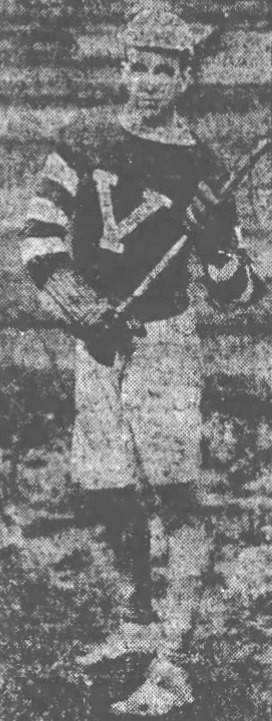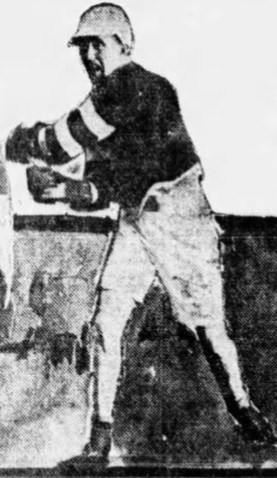PATRICK ‘PADDY’ McDONOUGH
(1883/84 – April 3, 1958)
Vancouver Greenshirts (1918)
Vancouver Terminals (1919-1920; 1923-1924)
Vancouver Lacrosse Club (1921)
Long-forgotten and obscure today, with a couple of blurry newspaper images to his name, Patrick ‘Paddy’ McDonough was a well-regarded journeyman player for Vancouver teams in the immediate years after the First World War and into the early 1920s.
An easterner hailing from the shores of Lake Simcoe in Ontario – with both Orillia and Beaverton mentioned as his hometown – nothing concrete is known of his early years nor where he learnt the game.
McDonough excelled both in ice hockey and lacrosse and in his early years as an athlete he moved about considerably between teams and cities, in both sports, from year to year, until ultimately finding his way out west to Vancouver and calling it home. He seems to have acquired the nickname ‘Paddy’ in Vancouver, while everywhere else tended to call him ‘Pat’.
Pat McDonough was referred to as “the famous lacrosse player” in an article printed in the Toronto Star in 1908. This is a rather surprising and astonishing statement considering the earliest mention of his name in a game report occurred only the year before. He had turned senior in 1904 and had played previously with such small-town teams as Port Hope, Fort William, and Beaverton – the latter location where he seems to have made his ‘famous’ name – but none of these were hardly any sort of world-beaters or powerhouses.
An early practitioner of the money game, McDonough was gaining enough attention around this time to try selling his services. He was slated to sign with the Toronto Tecumsehs of the professional National Lacrosse Union in 1907, but then got lured away the following month by an intermediate team from Peterborough playing two-tiers down in the Canadian Lacrosse Association league (no relation to the modern national governing body).
Toronto was rumoured to be offering him $300 for the entire season – which was expected to work out being $20 per game – while Peterborough upped the ante by offering him $25 per game. He went with the better deal on the table – but it ended up being a poor decision that backfired on him, as he ended up playing less games and Peterborough was always in danger of folding that season, and may have actually done so.
He then signed the following season with the Tecumsehs’ rivals in the National Lacrosse Union, the Toronto Lacrosse Club (the ‘Torontos’) in May 1908, but then much like he did with the Tecumsehs the year before, he soon jumped ship to play for the Chicago Shamrocks in a handful of games.
It is unknown whether any sort of employment had taken him stateside, nor the quality or type of league in which Chicago played, but by the following year he was acting as player-manager for the Shamrocks and had recruited over a dozen Canadians to fill their ranks. Two years later he was reported to be coaching the lacrosse team at Hobart College in upstate New York.
Around this time, he was also playing ice hockey in the winter months. He started out with teams in the Thunder Bay area, such as Fort William Wanderers in 1908 and a Port Arthur team around 1910; there may have also been some confusion which sport he was playing there, as lacrosse was experiencing a sudden boom in that area at this same time.
By 1911 he had moved on to Saskatoon and signed with a hockey team there. When the Great War came along, he was now in Nelson, British Columbia with three seasons of hockey there under his belt. It was likely during this time spent in the West Kootenay that he first came into contact with the Patrick brothers, Lester and Frank, whom would later employ him as an emergency referee and scout for their Pacific Coast Hockey Association.
His arrival in Vancouver, like much of his playing career, was just as murky. He was reported in June 1917 to be suiting up with the Vancouver squad in the patriotic lacrosse series games played for the war effort relief, however his involvement was limited to that of one of the timekeepers.
He then appeared for the ‘Greenshirts’ in the opening and closing matches of the 1918 Mainland Lacrosse Association campaign, picking up a couple of goals in his second appearance.
‘Paddy’ McDonough signed on with the Vancouver Terminals fulltime in 1919, and he could be found top of the midfield line at first home, or on the attack at inside home and occasionally outside home. As the season wore on, however, he started about half the matches as a substitute.
He paired by with ‘Dot’ Crookall on the attack in 1920 and became noted as one of the sharpshooters on the Terminals. This would be by far his most outstanding season, scoring 19 goals in 17 matches and finishing second in scoring for Vancouver, as well as winning much praise in the press in the process.
Returning to his team-jumping ways, he quit the Terminals in 1921 and signed with Con Jones’s upstart Pacific Coast Lacrosse Association. When the league folded in the second week of June, he found himself on the sidelines.
He was signed to referee PCHA pro hockey games in an emergency capacity for the 1921-22 season. After working one game, he was then sent off by the league on a scouting mission across the prairies in early 1922.
After sitting out the 1922 lacrosse season, he returned to the Vancouver Terminals the following year, but the two-year break from the game seems to have impacted and diminished his ability as he was often relegated to substitute duty.
When goaltender Jake Davis suddenly quit the team at the end of August 1923 to move to California for work, the Terminals were left scrambling to find a new backstop. Veteran keeper and future hall-of-famer Dave Gibbons had been out practising with the team, but he refused the role, claiming his eyesight was no longer good enough. Regarded as somewhat of a jack-of-all-trades, ‘Paddy’ McDonough stepped up and filled the hole in the crease.
His lone appearance in goal took place on September 3, 1923 in a close 9-7 loss to the New Westminster Salmonbellies. Despite previous club confidence with McDonough going into the match, he was replaced in the crease five days later by newcomer Andrew Jack.
McDonough’s lacrosse career ended the following year with the demise of the professional game in June 1924. Looking back at his lacrosse career in Vancouver, he scored a total of 36 goals and 2 assists in 48 games – good enough to place him 14th overall for career goals in the league and 5th in Vancouver team scoring. Statistically he is the best Vancouver pro field player from that era not in the Canadian Lacrosse Hall of Fame.
In 1942, lacrosse beater writer Andy Paull was asked who he thought “was the roughest player that had ever played”, and he replied with McDonough’s name. With ‘Paddy’ in his later years sometimes providing occasional ‘opinion quotes’ to fill space in the papers, it is difficult to tell if Paull was actually serious or just being humourous and witty with a knowing audience, as McDonough’s 7 penalties and 31 minutes made him practically a saint in the old rough and tumble field game.
In the mid-1930s McDonough returned to his ice hockey roots and scouted for NHL teams, notably for Frank Patrick when he was coach of the Boston Bruins for two seasons. Otherwise nothing is known about his employment nor any personal details, apart from living in the Lonsdale area of North Vancouver from 1941 onwards and operating a pool room there until a year before his passing. He seems to have remained a bachelor, as when Patrick McDonough passed away in 1958, his obituary mentioned he was only survived by a sister.
(PHOTO SOURCES: Vancouver Province unknown date; Vancouver Province June 3, 1920)


